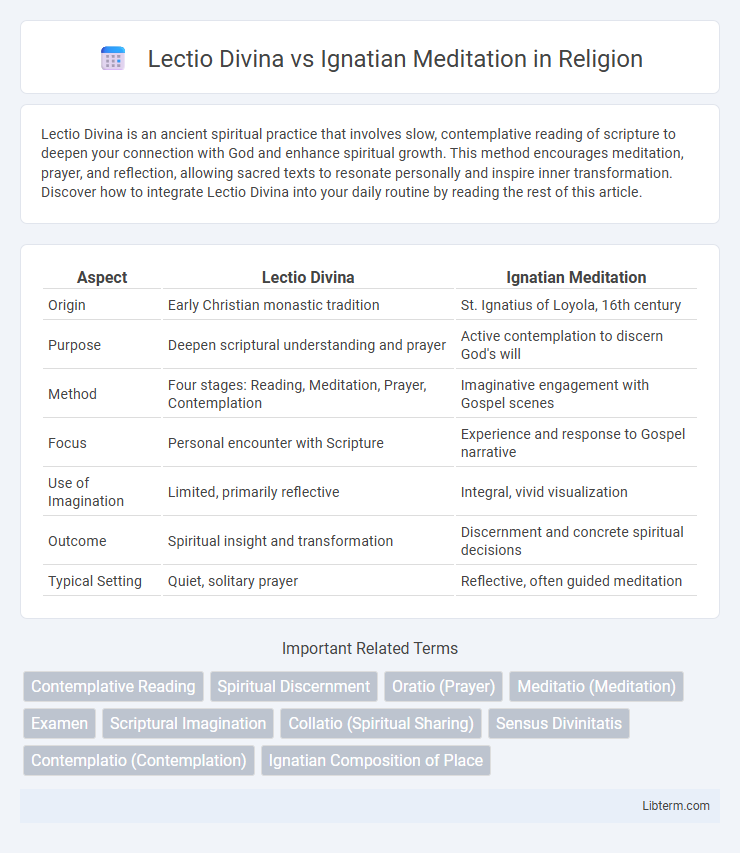Lectio Divina is an ancient spiritual practice that involves slow, contemplative reading of scripture to deepen your connection with God and enhance spiritual growth. This method encourages meditation, prayer, and reflection, allowing sacred texts to resonate personally and inspire inner transformation. Discover how to integrate Lectio Divina into your daily routine by reading the rest of this article.
Table of Comparison
| Aspect | Lectio Divina | Ignatian Meditation |
|---|---|---|
| Origin | Early Christian monastic tradition | St. Ignatius of Loyola, 16th century |
| Purpose | Deepen scriptural understanding and prayer | Active contemplation to discern God's will |
| Method | Four stages: Reading, Meditation, Prayer, Contemplation | Imaginative engagement with Gospel scenes |
| Focus | Personal encounter with Scripture | Experience and response to Gospel narrative |
| Use of Imagination | Limited, primarily reflective | Integral, vivid visualization |
| Outcome | Spiritual insight and transformation | Discernment and concrete spiritual decisions |
| Typical Setting | Quiet, solitary prayer | Reflective, often guided meditation |
Introduction to Christian Meditative Traditions
Lectio Divina and Ignatian Meditation represent two foundational Christian meditative traditions centered on scripture engagement and spiritual reflection. Lectio Divina emphasizes a contemplative reading, meditation, prayer, and contemplation cycle designed to deepen the soul's connection with God through sacred texts. Ignatian Meditation, developed by St. Ignatius of Loyola, incorporates imaginative prayer and discernment, inviting practitioners to immerse themselves in Gospel scenes to encounter Christ personally and respond to His call.
What is Lectio Divina?
Lectio Divina is an ancient Christian spiritual practice centered on the slow, contemplative reading of Scripture, aimed at deepening one's relationship with God through four key steps: reading (lectio), meditation (meditatio), prayer (oratio), and contemplation (contemplatio). Unlike Ignatian Meditation, which actively engages the imagination to immerse oneself in Gospel scenes, Lectio Divina emphasizes a more receptive and reflective approach to the Word of God. This method fosters inner transformation by allowing the Scripture's message to resonate personally and spiritually within the practitioner over time.
What is Ignatian Meditation?
Ignatian Meditation is a form of prayer rooted in the Spiritual Exercises of St. Ignatius of Loyola, emphasizing imaginative engagement with Scripture to deepen personal connection with God. This practice invites the individual to enter biblical scenes, using all senses to experience the narrative and discern God's presence and guidance. Unlike Lectio Divina, which primarily focuses on contemplative reading and reflection, Ignatian Meditation actively involves imaginative contemplation and decision-making aligned with spiritual growth.
Historical Background and Origins
Lectio Divina, rooted in early Christian monasticism dating back to the 3rd century with figures like Origen and developed by St. Benedict in the 6th century, emphasizes reflective and prayerful reading of Scripture. Ignatian Meditation originates from the Spiritual Exercises of St. Ignatius of Loyola in the 16th century, focusing on imaginative engagement and discernment based on biblical narratives. Both practices, while sharing meditative goals, arise from distinct historical contexts that shaped their methods and spiritual emphases.
Core Principles of Lectio Divina
Lectio Divina centers on four core principles: reading (lectio), meditation (meditatio), prayer (oratio), and contemplation (contemplatio), designed to foster a deep, prayerful engagement with Scripture. This method emphasizes a slow, reflective approach to biblical texts, allowing God's word to transform the soul through repeated reading and personal meditation. In contrast, Ignatian Meditation focuses more on imaginative engagement and active discernment based on the teachings of St. Ignatius of Loyola, differing in its method but sharing a goal of spiritual growth.
Key Elements of Ignatian Meditation
Ignatian Meditation centers on the active use of imagination to place oneself within a Gospel scene, engaging all senses to deepen personal encounter with Christ. Key elements include the composition of place, colloquy or conversation with Jesus, and reflective contemplation to discern God's will in daily life. This method contrasts with Lectio Divina's more passive, scripture-focused meditation by inviting dynamic interaction and decision-making inspired by the Spirit.
Differences in Practice and Approach
Lectio Divina emphasizes a slow, prayerful reading of Scripture, allowing the Word to deeply penetrate the heart through four distinct steps: reading, meditation, prayer, and contemplation. Ignatian Meditation, rooted in the Spiritual Exercises of St. Ignatius, involves imaginative engagement with biblical scenes, encouraging active reflection and personal response to God's presence and call. The key difference lies in Lectio Divina's passive receptivity and silence contrasted with Ignatian Meditation's dynamic visualization and discernment process.
Spiritual Benefits and Outcomes
Lectio Divina fosters deep scriptural immersion, enhancing contemplative prayer and spiritual awareness through meditative reading and reflection, leading to increased inner peace and divine connection. Ignatian Meditation emphasizes imaginative engagement and discernment, cultivating spiritual insight and purposeful decision-making by envisioning biblical scenes and applying lessons to daily life. Both practices enrich spiritual growth, but Lectio Divina offers tranquility and receptivity, while Ignatian Meditation drives active spiritual discernment and personal transformation.
Choosing the Right Method for You
Lectio Divina emphasizes slow, contemplative reading of Scripture, allowing the Word to deeply resonate within your heart, ideal for those seeking a prayerful connection through biblical text. Ignatian Meditation engages the imagination to immerse oneself in Gospel scenes, fostering active reflection and discernment suited for individuals inclined toward experiential spirituality and decision-making. Selecting between these methods depends on your personal prayer style: Lectio Divina suits contemplative readers craving spiritual insight, while Ignatian Meditation benefits those drawn to vivid, imaginative encounters with Scripture.
Integrating Lectio Divina and Ignatian Meditation
Integrating Lectio Divina and Ignatian Meditation enhances spiritual depth by combining the reflective reading of Scripture with imaginative prayer techniques. This fusion encourages active engagement with biblical texts through visualization and contemplative listening, fostering a personal encounter with God. Practitioners benefit from Lectio Divina's structured approach and Ignatian Meditation's dynamic, experiential focus, promoting holistic spiritual growth.
Lectio Divina Infographic

 libterm.com
libterm.com